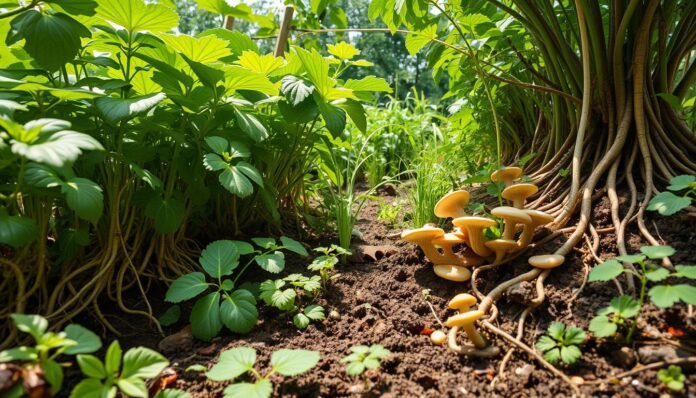What if the key to a more sustainable and productive ecosystem was hidden in plant roots? Mycorrhizal fungi are gaining attention for their role in permaculture. They form relationships with plant roots, offer essential nutrients, and enhance soil health. By understanding their role, gardeners and farmers can build more resilient ecosystems.
Permaculture mycorrhizal fungi are vital for plant growth and health. They provide extra nutrients, help plants survive droughts, and protect them from extreme conditions. Their use in permaculture is a cornerstone of sustainable agriculture, showing great promise in various practices.
Key Takeaways
- Permaculture mycorrhizal fungi form symbiotic relationships with plant roots, providing essential nutrients and improving soil health.
- The benefits of mycorrhizal fungi in permaculture practices include increased drought-tolerance and reduced stress in extreme environmental conditions.
- Permaculture mycorrhizal fungi can be used to create more sustainable and productive ecosystems.
- Mycorrhizal fungi deliver up to 80% of a plant’s phosphorus intake and provide up to 20% of a plant’s nitrogen.
- Permaculture practices that incorporate mycorrhizal fungi can lead to increased crop yields and reduced need for chemical fertilizers.
- Fungal networks in ecosystems store an estimated 8 times more carbon compared to ecosystems without mycorrhizal vegetation.
Introduction to Mycorrhizal Fungi
Mycorrhizal fungi are special fungi that live with plant roots. They help keep soil healthy and boost biodiversity. These fungi spread out like threads, making plants’ roots stronger.
These fungi are vital for our ecosystems. Knowing about them helps us see their value in permaculture. They offer many benefits, like:
- Improving soil structure and increasing drought tolerance
- Providing essential nutrients to plants, such as nitrogen, phosphorus, zinc, manganese, and copper
- Enhancing soil health and promoting ecosystem biodiversity
Mycorrhizal fungi greatly help plants grow and soil health. They make plants and animals grow more than without them. These fungi are key to any ecosystem, keeping soil healthy and biodiversity rich.
| Benefits of Mycorrhizal Fungi | Description |
|---|---|
| Improved Soil Structure | Increased drought tolerance and improved soil aeration |
| Essential Nutrients | Providing nutrients such as nitrogen, phosphorus, zinc, manganese, and copper |
| Enhanced Soil Health | Promoting ecosystem biodiversity and improving soil health |
The Role of Mycorrhizal Fungi in Soil Health
Mycorrhizal fungi are crucial for soil health. They improve soil structure and nutrient cycling. To boost their presence, we can reduce tillage, use cover crops, and grow diverse plant groups. Avoiding too much fertilizer is also key.
Here are some benefits of mycorrhizal fungi in soil health:
- They make soil better at holding water and air.
- They help plants get more nutrients.
- They increase the variety of fungi in the soil, making it stronger.
By supporting mycorrhizal fungi, we can make soil healthier. This leads to better crops and less harm to the environment. We can do this by reducing how much we till, using cover crops, and growing diverse plants.
Mycorrhizal fungi are vital for healthy soils. Their role in soil health is very important. By understanding their value, we can help them grow and thrive. This makes farming more sustainable and productive.
| Practice | Benefit |
|---|---|
| Reducing tillage | Increases mycorrhizal fungi abundance and diversity |
| Using cover crops | Improves soil structure and nutrient cycling |
| Growing plant polyculture | Enhances mycorrhizal fungi diversity and resilience |
Types of Mycorrhizal Fungi in Permaculture
Mycorrhizal fungi are key in permaculture. There are two main types: arbuscular mycorrhizal fungi (AMF) and ectomycorrhizal fungi. AMF work with many plants, while ectomycorrhizal fungi mainly help trees and woody plants.
Knowing about types of mycorrhizal fungi is vital for good permaculture design. Arbuscular mycorrhizal fungi help plants get nutrients and water better. Ectomycorrhizal fungi are special because they work with certain plants, like trees, in tough environments.
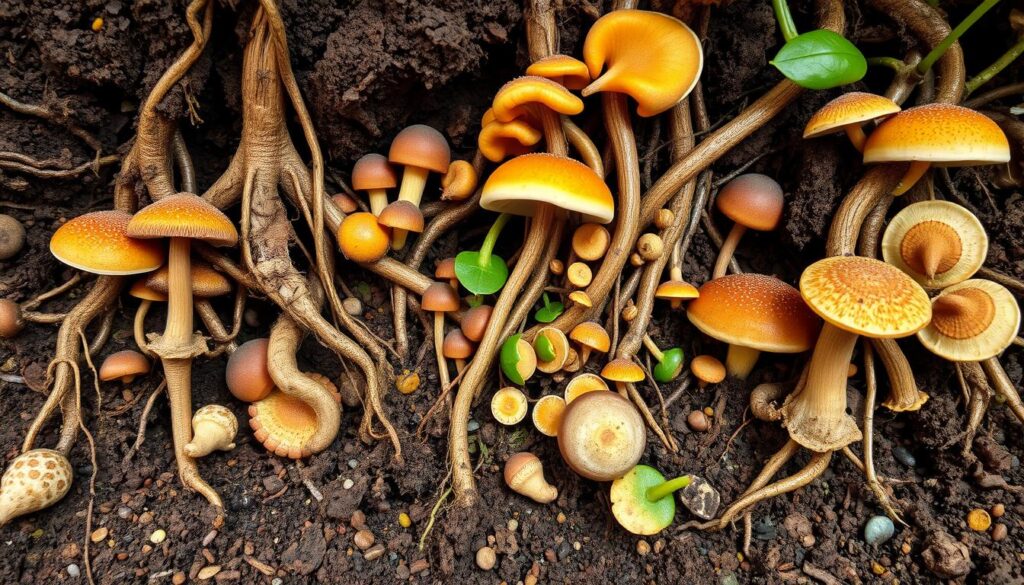
Using types of mycorrhizal fungi in permaculture has many benefits. They help plants get nutrients and water, improve soil, and help plants deal with drought and disease. By knowing how these fungi work with plants, permaculture designers can make better, more sustainable systems.
| Type of Mycorrhizal Fungi | Plant Species | Benefits |
|---|---|---|
| Arbuscular Mycorrhizal Fungi (AMF) | Wide range of plant species | Improved nutrient uptake, increased water efficiency |
| Ectomycorrhizal Fungi | Trees and woody plants | Improved nutrient uptake, increased stress tolerance |
How Mycorrhizal Fungi Promote Plant Growth
Mycorrhizal fungi are key in helping plants grow. They form special bonds with plant roots. This bond lets the fungi expand the root system, helping plants absorb more water and nutrients.
This relationship boosts plant health and productivity. It leads to better crop yields and helps plants handle droughts better.
The fungi’s role is clear in their ability to extend root systems and improve water absorption. This is crucial in dry areas, allowing plants to survive with less water. They also help plants take in more nutrients like phosphorus and nitrogen, which are essential for growth.
- Improved nutrient uptake efficiency
- Increased drought tolerance
- Enhanced soil structure
- Reduced reliance on chemical inputs
Understanding mycorrhizal fungi’s role in plant growth is vital. It helps us build a more sustainable food system. We can do this by using mycorrhizal fungi in farming. This reduces the need for harmful chemicals and supports regenerative farming.
Integrating Mycorrhizal Fungi into Permaculture Design
When adding mycorrhizal fungi to permaculture, picking compatible plant species is key. These plants work together with the fungi, making the soil healthier and plants grow better. Inoculation techniques like using fungi inoculum help spread these beneficial fungi in the soil.
To make it work, think about these points:
- Pick plants that go well with mycorrhizal fungi, like grasses and orchard trees.
- Use inoculation techniques to add fungi to the soil, like adding inoculum or using infected plant roots.
- Make sure the fungi have what they need to grow, like enough water, nutrients, and the right pH.
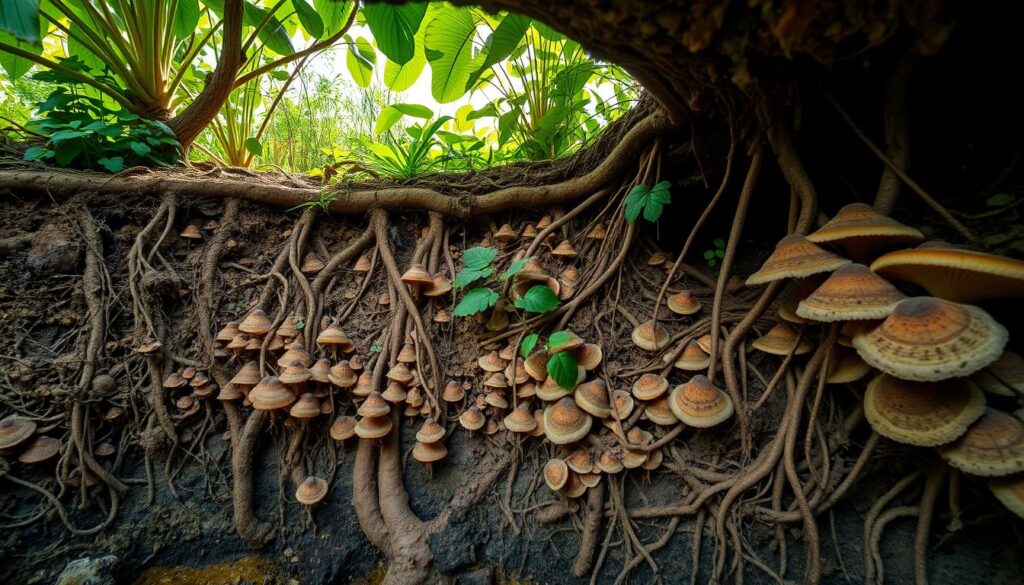
Adding mycorrhizal fungi to permaculture makes your ecosystem stronger and more sustainable. It improves soil health, boosts plant growth, and enhances ecosystem services. With the right compatible plant species and inoculation techniques, you can fully benefit from mycorrhizal fungi in your design.
| Plant Species | Mycorrhizal Fungi Association |
|---|---|
| Grasses | High association |
| Orchard Trees | High association |
| Vegetables | Low association |
Advantages of Using Mycorrhizal Fungi
Mycorrhizal fungi bring many benefits to permaculture. One key advantage is increased crop yields. They help plants grow better by working with their roots.
They also mean you need less chemical fertilizers. Mycorrhizal fungi help plants get more water and nutrients like phosphorus. This makes farming more eco-friendly.
Benefits for Plant Growth
Using mycorrhizal fungi boosts plant growth. It’s great for plants that need a lot of nutrients, like tomatoes and strawberries.
Cost-Effective Solutions
There are affordable ways to use mycorrhizal fungi in permaculture. For example, Fox’s Bushdoctor Microbe Brew is easy to apply. Mycorrhizal Applications, Inc. also has products you can buy online.
Adding mycorrhizal fungi to permaculture can help a lot. It leads to increased crop yields and less use of chemical fertilizers. This makes farming better for the planet and for people.
Challenges in Utilizing Mycorrhizal Fungi
Using mycorrhizal fungi can be tough due to environmental conditions and the specificity of fungal strains. These issues can impact how well the fungi grow and work. It’s crucial to manage the ecosystem well.
Some major challenges are:
- Soil pH, temperature, and moisture levels can affect mycorrhizal fungi growth.
- Fungal strains vary in how well they work with different plants.
- Managing the ecosystem is key to ensure mycorrhizal fungi thrive.
Despite these hurdles, mycorrhizal fungi bring many benefits to permaculture. They improve soil health and help plants grow better. By tackling these challenges, we can fully use these beneficial organisms.
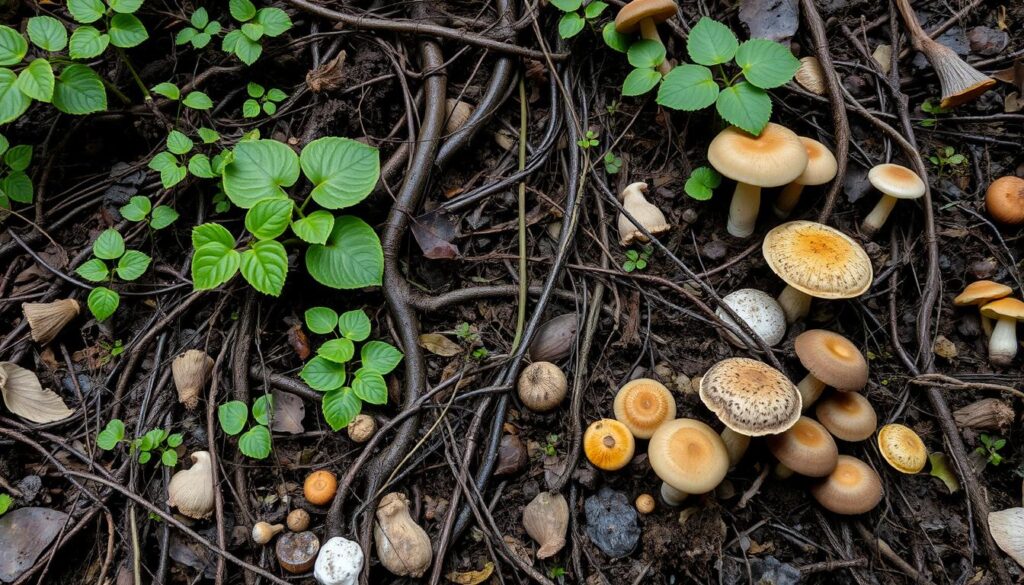
Mycorrhizal Fungi in Companion Planting
Mycorrhizal fungi help plants grow better together. They make the soil healthier and crops more abundant. By matching plants with these fungi, we build a strong and diverse garden.
Legumes and mycorrhizal fungi work well together, boosting soil nitrogen. Cover crops also help, keeping soil open for roots and fungi. Mulching with wood chips improves soil and supports fungi, as seen in growing dwarf apple trees.
The perks of using mycorrhizal fungi in gardening are clear:
- Soil health gets a boost from better nutrient and water use.
- Crops grow more because they take up nutrients more efficiently.
- Less pests and diseases mean a healthier garden.
Knowing how mycorrhizal fungi work in gardening helps us grow food better. This method leads to healthier, more productive plants. It’s a win-win for our gardens and the environment.
| Plant Species | Mycorrhizal Fungi Partner | Synergistic Benefits |
|---|---|---|
| Legumes | Glomus intraradices | Enhanced nitrogen levels |
| Apple Trees | Pisolithus arrhizus | Improved soil quality |
Assessing Mycorrhizal Fungi in the Garden
Understanding mycorrhizal fungi in your garden is key to better soil health and plant growth. By using soil testing methods, like measuring soil organic matter, you can learn a lot. Indicators of mycorrhizal presence, like fungal hyphae, show the health and variety of these fungi in the soil.
Some common indicators of mycorrhizal presence include:
- Presence of fungal hyphae
- Increased soil organic matter
- Improved soil structure
By assessing mycorrhizal fungi and using soil testing methods, gardeners can make smart choices. They can decide how to help these helpful microbes grow. This includes using indicators of mycorrhizal presence to check if gardening practices are working well.
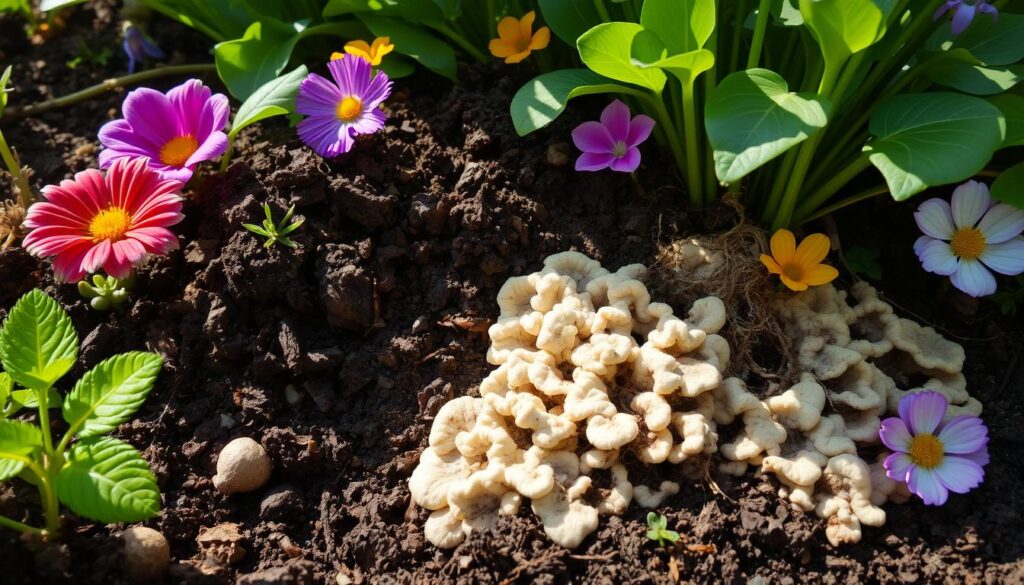
| Soil Testing Method | Indicator of Mycorrhizal Presence |
|---|---|
| Measuring soil organic matter | Presence of fungal hyphae |
| Assessing soil structure | Improved soil aggregation |
Legislation and Support for Mycorrhizal Research
Mycorrhizal fungi research has seen a lot of interest lately. There are many laws and support systems to help this research grow. In the U.S., policies and funding are key to moving mycorrhizal fungi research forward in permaculture.
Some important laws and support for mycorrhizal research include:
- Funding from government agencies like the National Science Foundation and the U.S. Department of Agriculture
- Grants and awards from private groups, like the Mycorrhizal Research Foundation
- Tax breaks for businesses and people investing in mycorrhizal research and development
These laws and support are vital for advancing mycorrhizal research and its use in permaculture. Knowing about current policies and funding helps researchers and users in the field. They can make a bigger impact in sustainable agriculture.
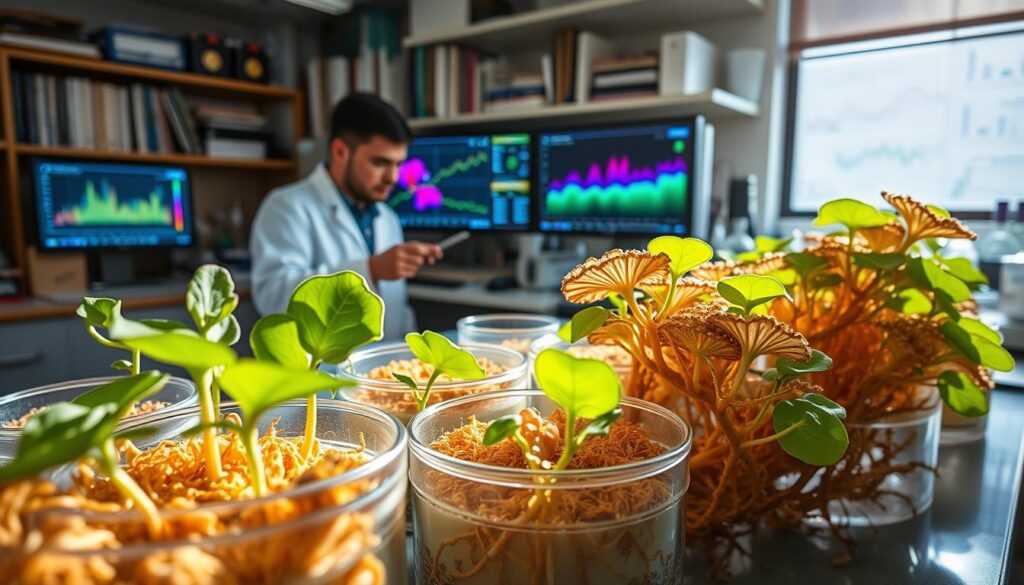
For instance, the U.S. Department of Agriculture offers funding for mycorrhizal fungi research. This support has led to big steps forward. New technologies and methods for using mycorrhizal fungi have been developed.
| Legislation and Support | Description |
|---|---|
| National Science Foundation | Funding for research on mycorrhizal fungi and their applications in agriculture |
| U.S. Department of Agriculture | Grants and awards for research on mycorrhizal fungi and their applications in agriculture |
Future Trends in Mycorrhizal Fungi Research
Researchers are diving deep into the world of mycorrhizal fungi. They’re finding new ways to use these fungi. One big area is sustainable agriculture. Here, mycorrhizal fungi can cut down on chemical fertilizers and make soil healthier.
Some exciting uses for mycorrhizal fungi include:
- Bioremediation: cleaning polluted soil and water with fungi
- Soil conservation: improving soil structure and reducing erosion
- Crop enhancement: boosting crop yields and plant nutrition
These future trends in mycorrhizal fungi research are big for sustainable agriculture. They could make farming less harmful to the environment. As research grows, we’ll see even more creative uses of mycorrhizal fungi.
Conclusion: The Future of Mycorrhizal Fungi in Permaculture
The future of mycorrhizal fungi in permaculture looks bright. These fungi can greatly benefit our farming methods. They help reduce the need for chemical fertilizers, improve soil health, and boost crop yields.
To make the most of this, we need to work together. We must keep learning about mycorrhizal fungi research and involve more people. This way, we can create better, greener farming practices for everyone.
Both permaculture experts and gardeners have a big part to play. By joining in the research and use of these fungi, we can make a real difference. Together, we can develop new, eco-friendly farming methods that benefit our planet.

